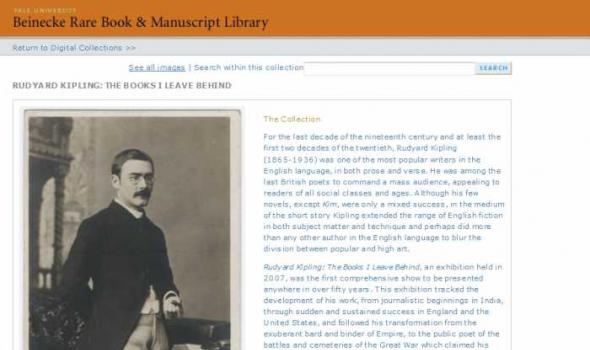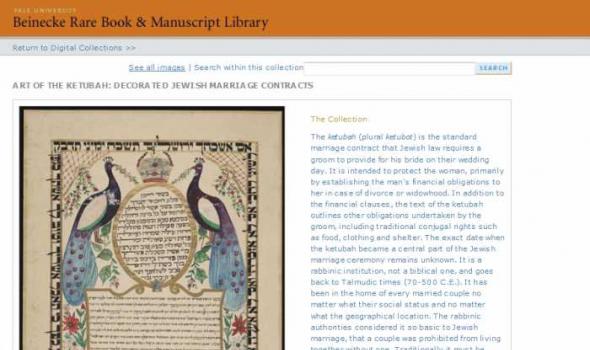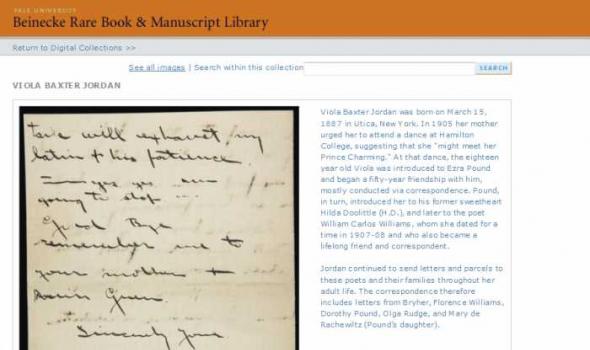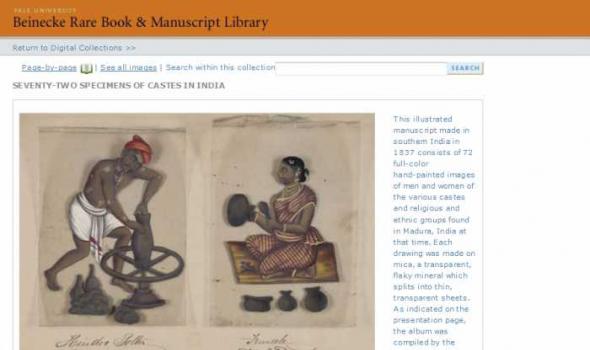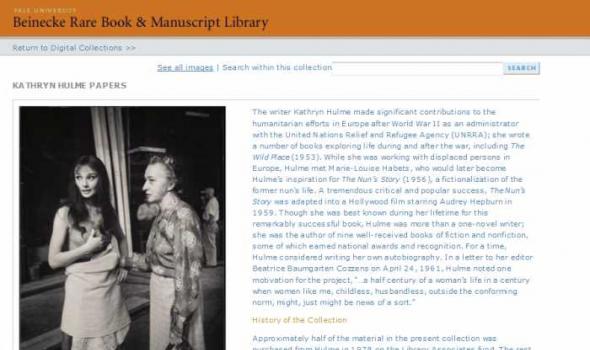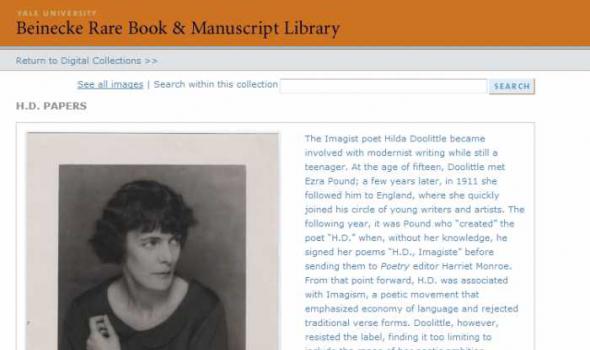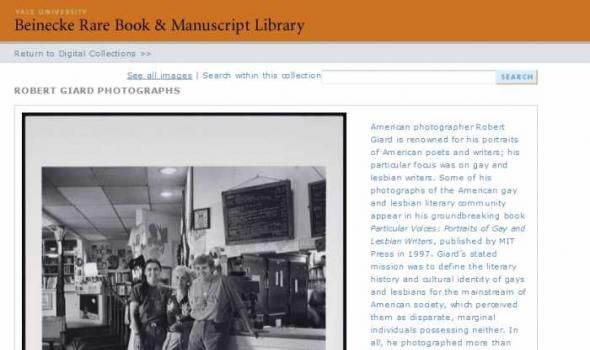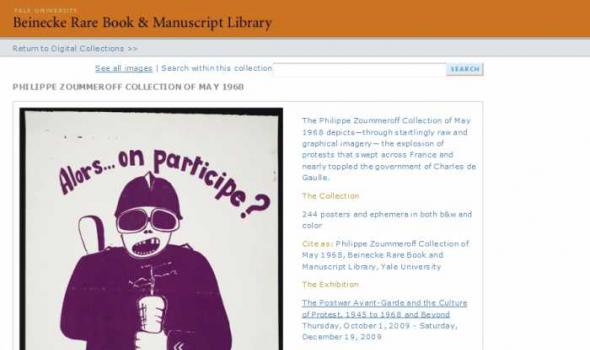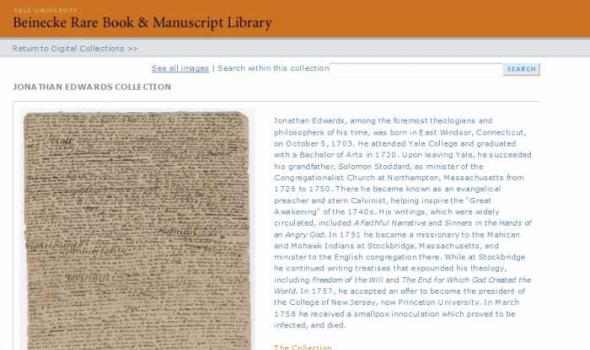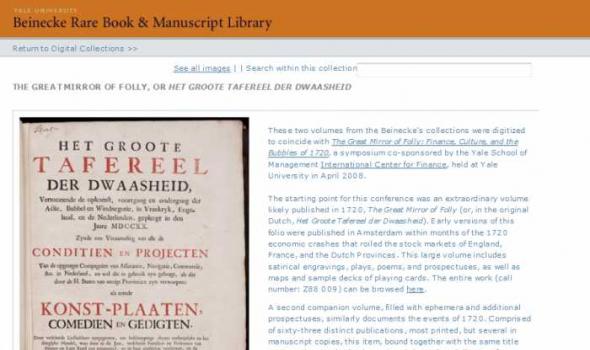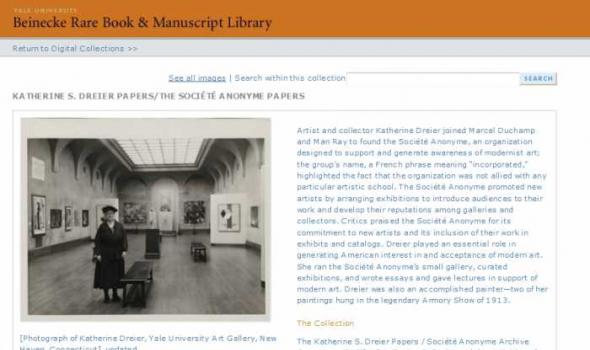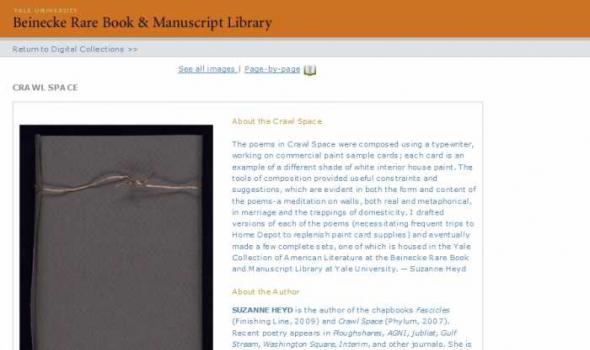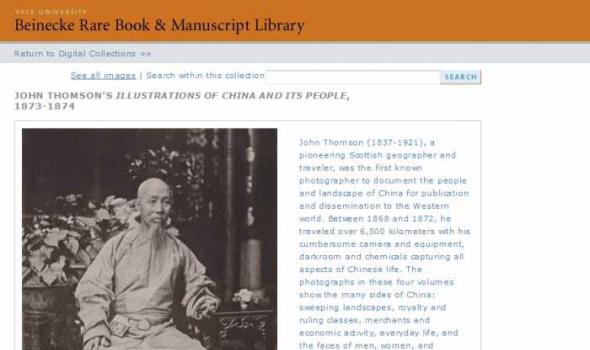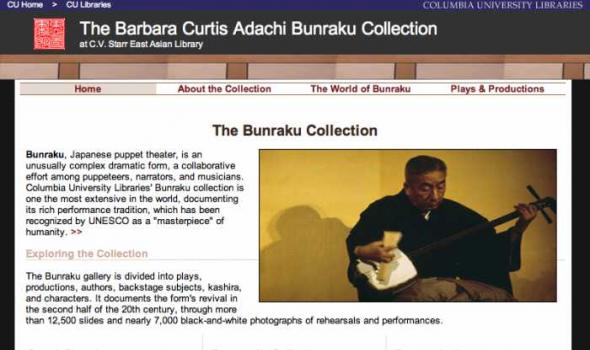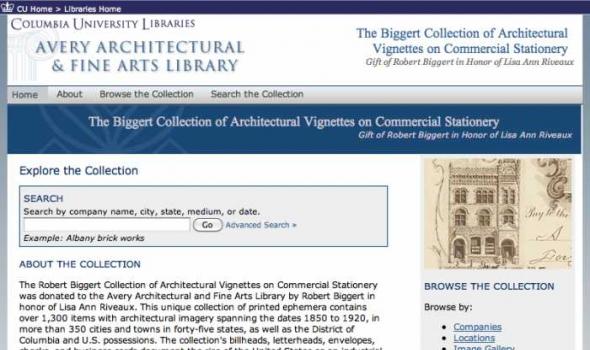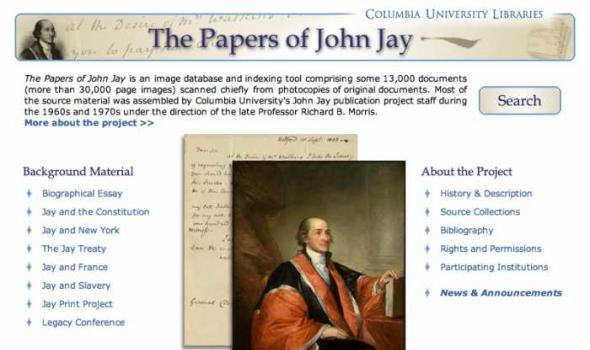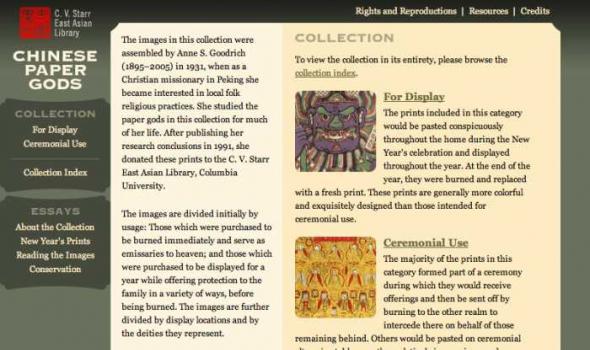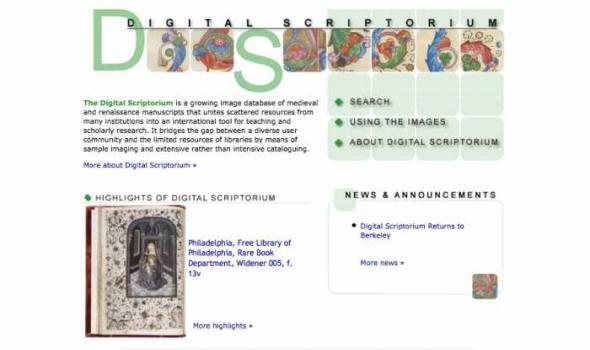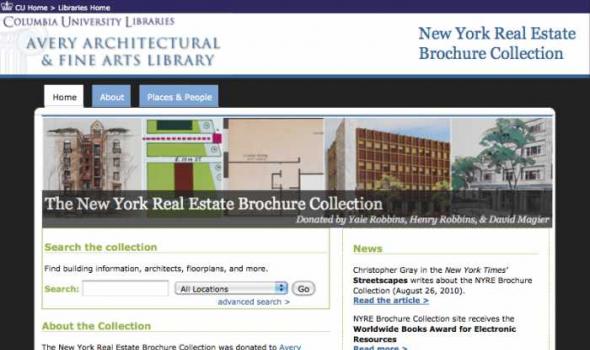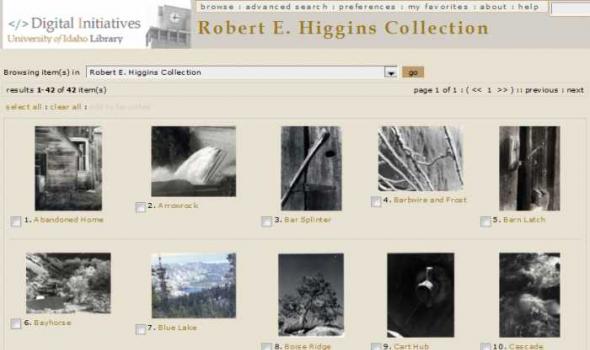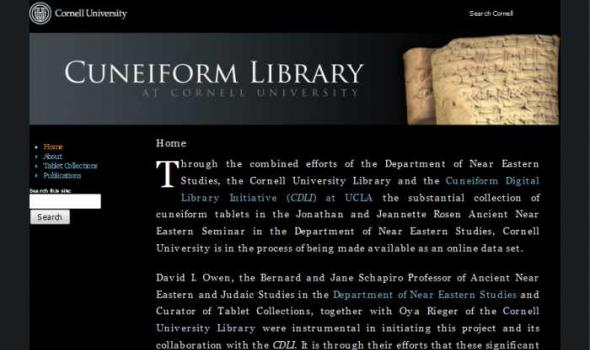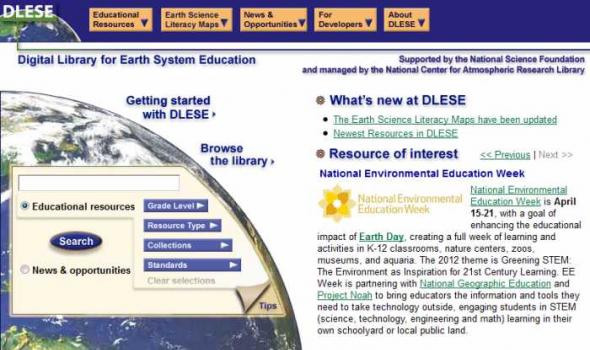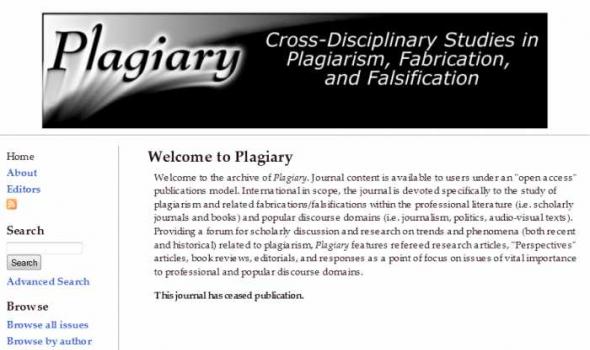Category
Results
For the last decade of the nineteenth century and at least the first two decades of the twentieth, Rudyard Kipling (1865-1936) was one of the most popular writers in the English language, in both prose and verse. He was among the last British poets to command a mass audience, appealing to readers of all social classes and ages. Although his few novels, except Kim , were only a mixed success, in the medium of the short story Kipling extended the range of English fiction in both subject matter and technique and perhaps did more than any other author in the English language to blur the division between popular and high art. Rudyard Kipling: The Books I Leave Behind , an exhibition held in 2007, was the first comprehensive show to be presented anywhere in over fifty years.
Ketubah, marriage contract, manuscript, ink and paint on paper, 20th of Menahem 5671 [1911 August 14], Bombay, India The ketubah (plural ketubot ) is the standard marriage contract that Jewish law requires a groom to provide for his bride on their wedding day. It is intended to protect the woman, primarily by establishing the man's financial obligations to her in case of divorce or widowhood. In addition to the financial clauses, the text of the ketubah outlines other obligations undertaken by the groom, including traditional conjugal rights such as food, clothing and shelter. The exact date when the ketubah became a central part of the Jewish marriage ceremony remains unknown. It is a rabbinic institution, not a biblical one, and goes back to Talmudic times (70-500 C.E.).
[Autographed letter signed] 1905 July 12, Wyncote, Pennsylvania [from] Ezra Pound These materials may be under copyright. To learn more, contact the Curator, Yale Collection of American Literature. Call Number: YCAL MSS 175 Related Collections Ezra Pound Papers, YCAL MSS 43 William Carlos Williams papers, YCAL MSS 116 H. D. Papers, YCAL MSS 24 Bryher papers, GEN MSS 97
From the sixteenth through the nineteenth centuries, the royal and aristocratic courts behind Europe’s most illustrious festivals printed elaborate, illustrated volumes to record the celebrations that they organized to mark births, deaths, betrothals, weddings, coronations, and visits. Often circulated for the benefit of rival noble families and in the interests of self promotion, festival books are fascinating witnesses to aristocratic culture and art during the Early Modern period.
The Collection Just under 300 engravings, watercolors, and illustrations drawn from books, archival collections, and artwork from the Beinecke Library's Western Americana and General collections. Cite as: Beinecke Rare Book and Manuscript Library, Yale University
Portraits represent various tribal groups, including, among many others, the Apache Indians, Arapaho Indians, Arikara Indians, Bannock Indians, Cherokee Indians, Cheyenne Indians, , Oglala Indians, Ojibwa Indians, Omaha Indians, Oohenonpa Indians, Santee Indians, Seminole Indians, Tohono O’odham Indians, Ute Indians, Wichita Indians, and Yuma Indians. Exterior images consist primarily of informal portraiture, as well as depicting residences and settlements, including the Crow Indian Agency in Montana, 1871; the Pawnee Indian School and buildings at the Pawnee Reserve, Loup Fork, Nebraska, 1871; and a Bannock Indian camp near Fort Hall, Idaho, 1872.
This illustrated manuscript made in southern India in 1837 consists of 72 full-color hand-painted images of men and women of the various castes and religious and ethnic groups found in Madura, India at that time. Each drawing was made on mica, a transparent, flaky mineral which splits into thin, transparent sheets. As indicated on the presentation page, the album was compiled by the Indian writing master at an English school established by American missionaries in Madura, and given to the Reverend William Twining. The manuscript shows Indian dress and jewelry adornment in the Madura region as they appeared before the onset of Western influences on South Asian dress and style.
was adapted into a Hollywood film starring Audrey Hepburn in 1959. Though she was best known during her lifetime for this remarkably successful book, Hulme was more than a one-novel writer; she was the author of nine well-received books of fiction and nonfiction, some of which earned national awards and recognition. For a time, Hulme considered writing her own autobiography.
Gift of Langston Hughes and bequest of the estate of Langston Hughes, ca. 1940-67. These materials may be under copyright. Permission from the Langston Hughes Estate is required to publish materials by Langston Hughes in any format. Contact information for the Estate may be found in the WATCH File . To learn more, contact the appropriate curator. Call Number: JWJ MSS 26
The H.D. Papers are the bequest of Norman Holmes Pearson, H.D.'s literary executor. Most of the material in the H. D. Papers came to the Beinecke Rare Book and Manuscript Library after Professor Pearson's death in 1973. Prior to this time, selected groups of materials were given to the library by Professor Pearson and were placed with related documents in other collections; these materials have been retrieved and placed in the H.D. Papers. Materials from other sources are also found in the papers, with specific provenance information on the appropriate folders. Permission from the H.D. Estate is required to publish H.D. materials in any format. To learn more, contact the Curator, Yale Collection of American Literature. Call Number: YCAL MSS 24
Witold Gombrowicz (1904-1969), was a Polish novelist and playwright. His novels and plays include Ferdydurke (1937), Trans-Atlantyk (1953), Ślub (1953), Kosmos (1965), and Pornografia (1966). Considered one of Poland's foremost literary figures of the twentieth century, Gombrowicz's novels and plays have been translated into many languages. The Collection The archive consists of correspondence, writings, personal papers, photographs, audiovisual material and memorabilia documenting Gombrowicz’s life and literary activity chiefly during the last two decades of his life (1949-69). Currently, only a portion of the Archive is available online.
American photographer Robert Giard is renowned for his portraits of American poets and writers; his particular focus was on gay and lesbian writers. Some of his photographs of the American gay and lesbian literary community appear in his groundbreaking book Particular Voices: Portraits of Gay and Lesbian Writers , published by MIT Press in 1997. Giard’s stated mission was to define the literary history and cultural identity of gays and lesbians for the mainstream of American society, which perceived them as disparate, marginal individuals possessing neither. In all, he photographed more than 600 writers. The archive is a unique and important collection providing a significant resource for the study of literary America in the late twentieth century.
In the autumn of 1609, the Italian mathematician and astronomer Galileo Galilei turned his telescope to the heavens, deciphering the cratered face of the moon, the four satellites of Jupiter, and other previously opaque features of the heavens. When, in 1610, Galileo published his Sidereus Nuncius, or Starry Messenger, the German astronomer Johannes Kepler responded with enthusiasm, praising the significance of Galileo’s observations with his own Dissertatio cum Nuncio Sidereo, or, Conversations with the Starry Messenger (1610). To whom else did the stars speak in the early modern period?
244 posters and ephemera in both b&w and color Cite as: Philippe Zoummeroff Collection of May 1968, Beinecke Rare Book and Manuscript Library, Yale University The Postwar Avant-Garde and the Culture of Protest, 1945 to 1968 and Beyond Thursday, October 1, 2009 - Saturday, December 19, 2009 Share |
1 July 1944 Richard Wright (1908-1960) is perhaps best known for his critically-acclaimed collection Uncle Tom’s Children: Four Novellas (1938), his groundbreaking novel Native Son (1940) and his autobiography, first published as Black Boy: A Record of Childhood and Youth (1945). Black Boy was the on the bestseller list from April 29 to June 6 of that year, despite being denounced as obscene in the U.S. Senate by Democrat Theodore Bilbo of Mississippi, and it solidified Wright’s reputation, at the time, as the most famous black author in America.
Jonathan Edwards, among the foremost theologians and philosophers of his time, was born in East Windsor, Connecticut, on October 5, 1703. He attended Yale College and graduated with a Bachelor of Arts in 1720. Upon leaving Yale, he succeeded his grandfather, Solomon Stoddard, as minister of the Congregationalist Church at Northampton, Massachusetts from 1726 to 1750. There he became known as an evangelical preacher and stern Calvinist, helping inspire the "Great Awakening" of the 1740s. His writings, which were widely circulated, included A Faithful Narrative and Sinners in the Hands of an Angry God. In 1751 he became a missionary to the Mahican and Mohawk Indians at Stockbridge, Massachusetts, and minister to the English congregation there.
These two volumes from the Beinecke's collections were digitized to coincide with The Great Mirror of Folly: Finance, Culture, and the Bubbles of 1720 , a symposium co-sponsored by the Yale School of Management International Center for Finance , held at Yale University in April 2008. The starting point for this conference was an extraordinary volume likely published in 1720, The Great Mirror of Folly (or, in the original Dutch, Het Groote Tafereel der Dwaasheid ). Early versions of this folio were published in Amsterdam within months of the 1720 economic crashes that roiled the stock markets of England, France, and the Dutch Provinces.
Katherine S. Dreier Papers / Société Anonyme Archive Artist and collector Katherine Dreier joined Marcel Duchamp and Man Ray to found the Société Anonyme, an organization designed to support and generate awareness of modernist art; the group’s name, a French phrase meaning “incorporated,” highlighted the fact that the organization was not allied with any particular artistic school. The Société Anonyme promoted new artists by arranging exhibitions to introduce audiences to their work and develop their reputations among galleries and collectors. Critics praised the Société Anonyme for its commitment to new artists and its inclusion of their work in exhibits and catalogs. Dreier played an essential role in generating American interest in and acceptance of modern art.
, which described the second Powell expedition, in 1908. He died in New York City on January 29, 1935. Over 800 digital images shown selected from nearly 900 photographic prints, relief halftones, postcards, negatives, tintypes and pen and ink drawings in Dellenbaugh’s personal collection. Depicting the Colorado River region and other areas of the West, these photographs include works by E. O. Beaman, James Fennemore, and John K. Hillers, photographers on the 1871 Powell expedition, as well as halftone prints of their images, apparently created for inclusion in Dellenbaugh's books. Photographs by Dellenbaugh and other amateur photographers are accompanied by images from professional photographers William Henry Jackson and the Kolb Brothers.
About the Crawl Space The poems in Crawl Space were composed using a typewriter, working on commercial paint sample cards; each card is an example of a different shade of white interior house paint. The tools of composition provided useful constraints and suggestions, which are evident in both the form and content of the poems-a meditation on walls, both real and metaphorical, in marriage and the trappings of domesticity. I drafted versions of each of the poems (necessitating frequent trips to Home Depot to replenish paint card supplies) and eventually made a few complete sets, one of which is housed in the Yale Collection of American Literature at the Beinecke Rare Book and Manuscript Library at Yale University.
John Thomson’s Illustrations of China and Its People, 1873-1874 John Thomson (1837-1921), a pioneering Scottish geographer and traveler, was the first known photographer to document the people and landscape of China for publication and dissemination to the Western world. Between 1868 and 1872, he traveled over 6,500 kilometers with his cumbersome camera and equipment, darkroom and chemicals capturing all aspects of Chinese life. The photographs in these four volumes show the many sides of China: sweeping landscapes, royalty and ruling classes, merchants and economic activity, everyday life, and the faces of men, women, and children. Thomson was born in Edinburgh, Scotland, the son of a tobacco spinner and seller.
